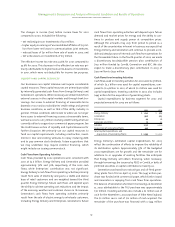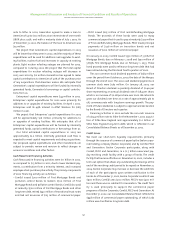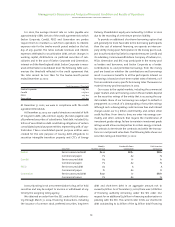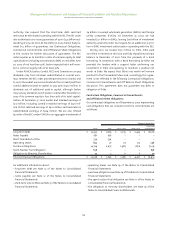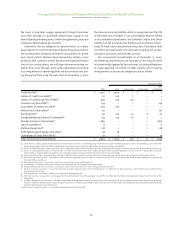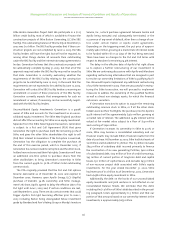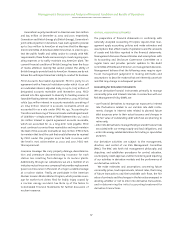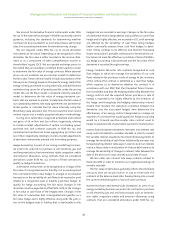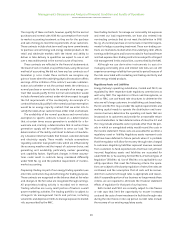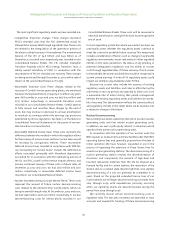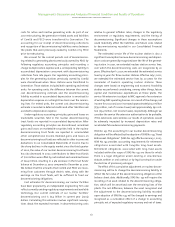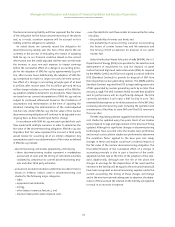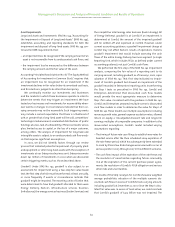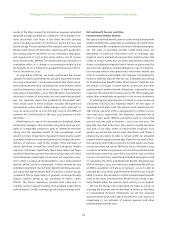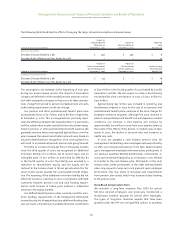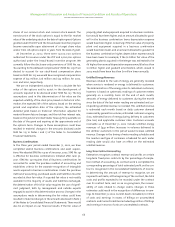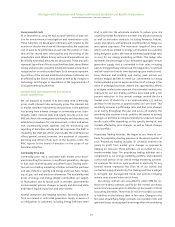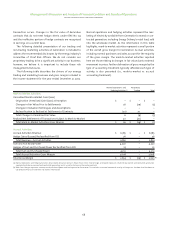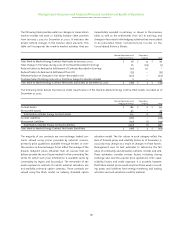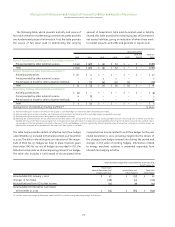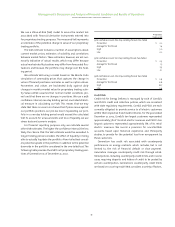ComEd 2002 Annual Report Download - page 63
Download and view the complete annual report
Please find page 63 of the 2002 ComEd annual report below. You can navigate through the pages in the report by either clicking on the pages listed below, or by using the keyword search tool below to find specific information within the annual report.
61
costs for active and inactive generating units. As part of our
2001 restructuring, the generation-related assets and liabilities
of ComEd and PECO were transferred to Generation. The
accounting for our receipt of decommissioning collections
and recognition of decommissioning liabilities varies between
the plants that were previously owned by ComEd or by PECO
prior to restructuring.
We account for the current period’s cost of decommission-
ing related to generating plants previously owned by PECO by
following regulatory accounting principles and recording a
charge to depreciation expense and a corresponding liability in
accumulated depreciation concurrent with decommissioning
collections from rate payers. Our regulatory accounting princi-
ples for the generating stations previously owned by ComEd
were discontinued when those stations were transferred to
Generation.Those stations included both operating and retired
units. For operating units, the difference between the current
cost decommissioning estimate and the decommissioning
liability recorded in accumulated depreciation is amortized to
depreciation expense on a straight-line basis over the remain-
ing lives. For retired units, the current cost decommissioning
estimate is recorded in deferred credits and other liabilities and
accreted to depreciation expense.
Under regulatory accounting principles, gains and losses on
marketable securities held in the nuclear decommissioning
trust funds are reported in accumulated depreciation. After
regulatory accounting principles are discontinued, unrealized
gains and losses on marketable securities held in the nuclear
decommissioning trust funds are reported in accumulated
other comprehensive income. Realized gains and losses on
decommissioning trust funds are reflected in other income and
deductions in our Consolidated Statements of Income. Due to
the sharp declines in the equity market since the third quarter
of 2000, the value of our nuclear decommissioning trust funds
has also decreased. In 2002, contributions to these trust funds
of $112 million were offset by net realized and unrealized losses
of $224 million, resulting in a 4% decrease in the trust funds’
balance at December 31, 2002 compared to December 31, 2001.
We believe that the amounts that ComEd and PECO are recov-
ering from customers through electric rates, along with the
earnings on the trust funds, will be sufficient to fund our
decommissioning obligations.
Cost estimates for decommissioning our nuclear facilities
have been prepared by an independent engineering firm and
reflect currently existing regulatory requirements and available
technology. Our current estimate of our nuclear facilities’
decommissioning cost is $7.4 billion in current year (2003)
dollars. Calculating this estimate involves significant assump-
tions about the expected increases in decommissioning costs
relative to general inflation rates, changes in the regulatory
environment or regulatory requirements, and the timing of
decommissioning. Significant changes in these assumptions
could materially affect the liabilities and future costs related
to decommissioning recorded in our Consolidated Financial
Statements.
The estimated service life of the nuclear station is also a
significant assumption because decommissioning and depreci-
ation costs are generally recognized over the life of the generat-
ing station. In 2001, we extended nuclear station service lives,
over which the decommissioning costs are recognized, by 20
years. Effective April 1, 2001, we extended the estimated service
lives by 20 years for three nuclear stations. Effective July 1,2001,
we extended the estimated service lives by 20 years for the
remainder of Exelon’s operating nuclear stations. These
changes were based on engineering and economic feasibility
studies we performed considering, among other things, future
capital and maintenance expenditures at these plants. The
service life extension is subject to NRC approval of an extension
of existing NRC operating licenses.As a result of the change,net
income for 2002 and 2001 increased approximately $132 million
($79 million, net of income taxes) and approximately $90 mil-
lion ($54 million, net income taxes), respectively. Although we
consider the service life extension authorization to be probable,
if the extensions were denied, our results of operations would
be adversely impacted by increased depreciation rates and
accelerated future decommissioning payments.
SFAS No. 143. The accounting for our nuclear decommissioning
obligation will be affected by the adoption of SFAS No.143,“Asset
Retirement Obligations” (SFAS No. 143) effective January 1, 2003.
SFAS No. 143 provides accounting requirements for retirement
obligations associated with tangible long-lived assets.
Retirement obligations associated with long-lived assets
included within the scope of SFAS No. 143 are those for which
there is a legal obligation under existing or enacted law,
statute, written or oral contract or by legal construction under
the doctrine of promissory estoppel.
The effect of this cumulative adjustment on nuclear decom-
missioning will be to change the decommissioning liability to
reflect the fair value of the decommissioning obligation at the
balance sheet date. Additionally, SFAS No. 143 will require the
recording of an asset related to the decommissioning obliga-
tion, which will be amortized over the remaining lives of the
plants. The net difference, between the asset recognized and
the adjustment to the decommissioning liability recorded
upon adoption of SFAS No. 143, will be charged to earnings and
recognized as a cumulative effect of a change in accounting
principle, net of expected regulatory recovery and net of taxes.
Management’s Discussion and Analysis of Financial Condition and Results of Operations
exelon corporation and subsidiary companies


